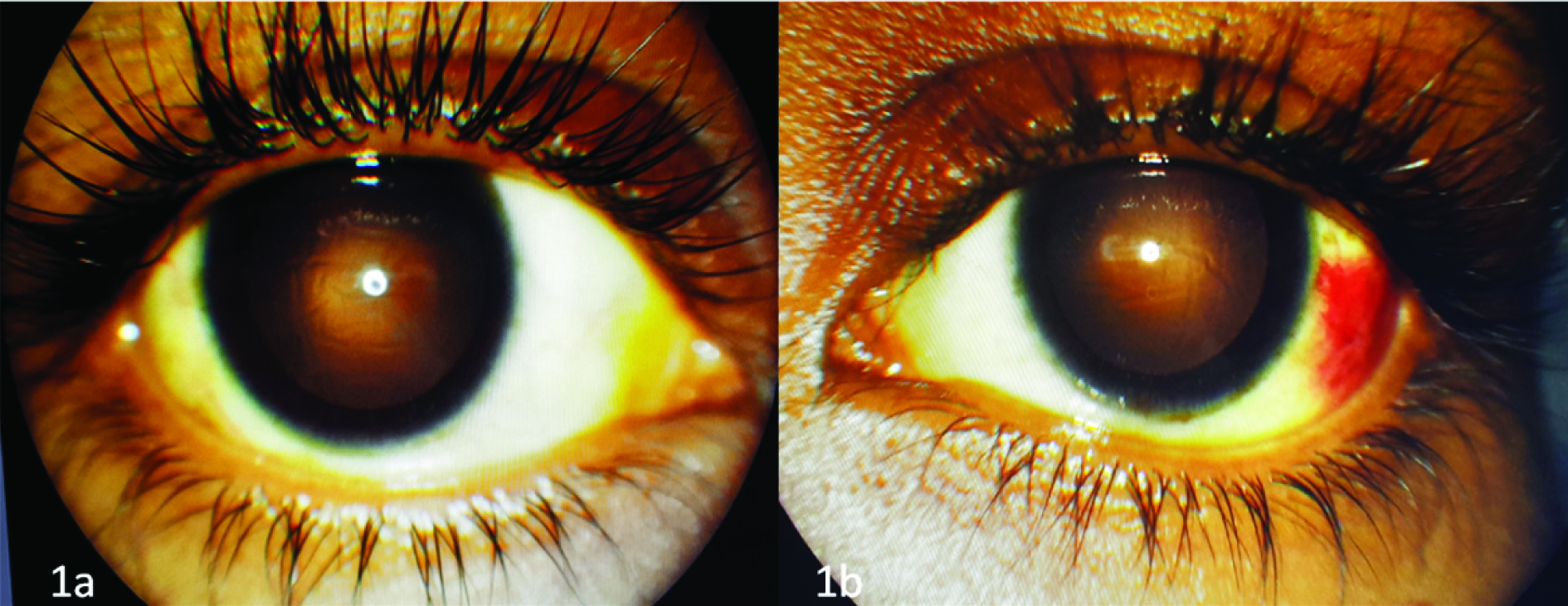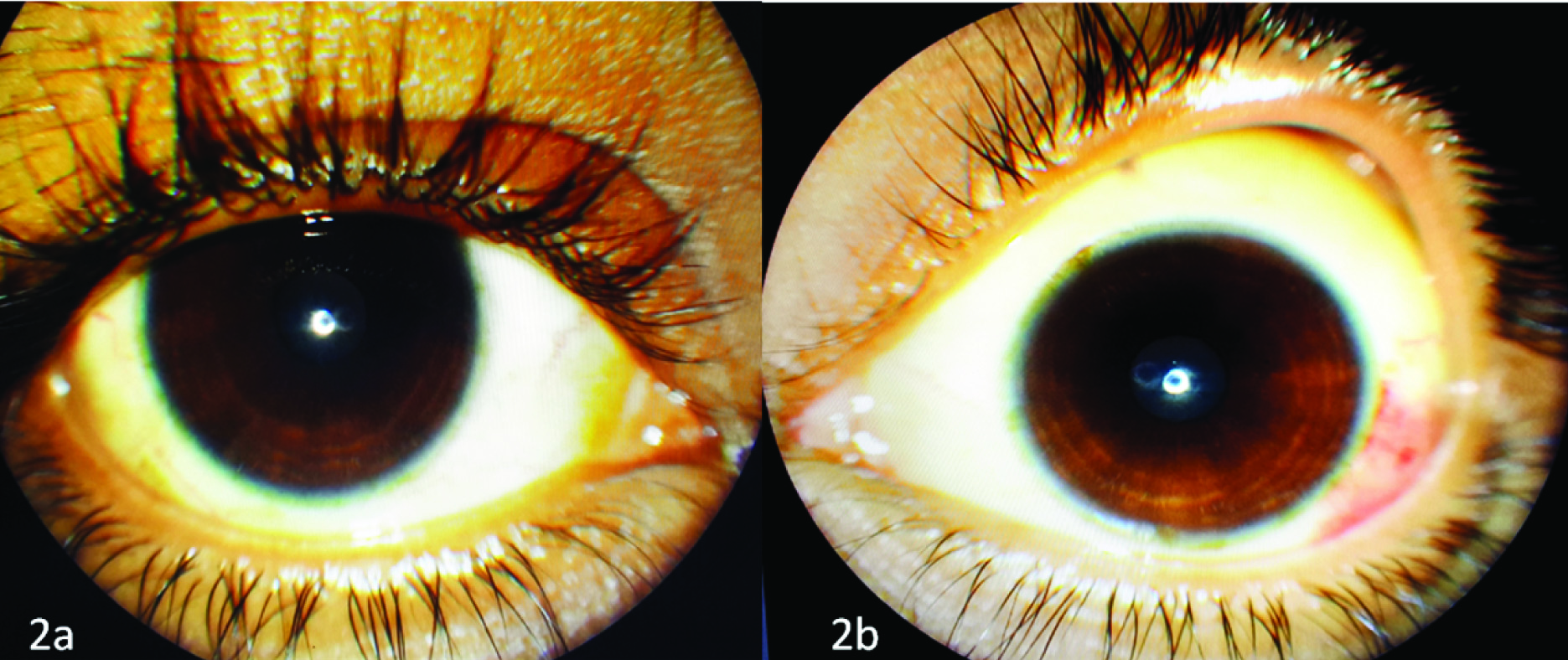An Inquisitive Case of Transient Corneal Oedema
Bijnya Birajita Panda1, Sucheta Parija2, Susanta Pujahari3, Jyotiranjan Mallick4
1 Senior Resident, Department of Ophtamology, AIIMS, Bhubaneswar, Odisha, India.
2 Assistant Professor, Department of Ophtamology, AIIMS, Bhubaneswar, Odisha, India.
3 Senior Resident, Department of Ophtamology, AIIMS, Bhubaneswar, Odisha, India.
4 Senior Resident, Department of Ophtamology, AIIMS, Bhubaneswar, Odisha, India.
NAME, ADDRESS, E-MAIL ID OF THE CORRESPONDING AUTHOR: Dr. Bijnya Birajita Panda, Senior Resident, AIIMS, Bhubaneswar, Odisha, India.
E-mail: bigyan_panda@yahoo.co.in
Hyperosmotics,Stromal corneal edema,Viral hepatitis
A 23-year-old female presented to our ophthalmology clinic in Odisha with chief complaints of blurring of vision in both eyes for one week duration. She complained of fever on and off, vomiting, loss of appetite and yellow sclera for last one month duration. She was diagnosed to have malaria (P.falciparum and P.vivax positive) and hepatitis for which she had been treated at a tertiary care hospital for last one week. She had no history of oral contraceptive use, amantadine use, contact lens usage, high altitudinal travel, any history of myxoedema or hypercholestraemia. On ocular examination her BCVA was 6/18 in right eye and 6/12 in left eye. The keratometry findings and refractive error measured by automated refracto-keratometer were within normal ranges. RE: —1.25DS/—1.00DCX91°, LE: —1.50DS/-0.25DCX125° (ruled out keratoconus). Pupillary examination and extra ocular movements were within normal limits. A slit-lamp exam revealed bilateral stromal oedema, without any obvious guttata in both eye [Table/Fig-1a&b]. Her Pachymetry (contact ultrasonic method) readings were 672 μm in right eye and 609 μm for the left eye. Non contact tonometry readings were recorded to be 7 and 8 in right and left eye respectively (falsely low due to corneal oedema). Her dilated fundus examination was unremarkable.
a) External photograph showing significant corneal oedema in right eye; and (b) left eye.

On physical examination, she had tender hepatomegaly. Chest and cardiovascular system examinations were within reference ranges. Blood investigations revealed highly deranged liver function test (SGOT- 1024, SGPT-828, ALP-724, serum total bilirubin-10.1, serum protein- 6.7). Her IgM anti-HEV was 7.89 (highly positive) and serology for hepatitis A, hepatitis B, hepatitis C, HIV, dengue and Leptospira was negative. Her peripheral blood smear and malaria test was negative: USG abdomen revealed thickened and oedematous gall bladder. With all the above findings, we came to a conclusion that the cause of decreased vision in this patient was due to the marked descemet folds in coexistence of acute viral hepatitis E. We treated the patient with topical Sodium chloride 6% ointment three times daily for one week. On follow up after seven days, the corneal oedema had resolved completely and her vision regained to 6/6 in both eyes [Table/Fig-2a&b]. There was no recurrence at her follow up visit after one month and hence asked to review as and when required.
a) Resolved corneal oedema after seven days of treatment as evident in right eye; and b) left eye.

Corneal oedema may be seen during the convalescence phase of hepatitis associated with canine adenovirus 1(CAdV 1) infection in dogs and other canids [1]. This entity has been reported in dogs but never been reported in human beings till date. We report the first case of bilateral corneal oedema during convalescence phase of hepatitis –E in a young female.
The dilemma in this case was to find the aetiology of the corneal oedema. What had caused this transient episode of bilateral corneal oedema? The aetiology of corneal oedema can be attributed to corneal endothelial disorders, few inflammatory conditions, trauma, post surgery and exposure to toxins. Endothelial disorders include Fuchs’ endothelial dystrophy, posterior polymorphous corneal dystrophy and Chandler’s syndrome. Our patient had no obvious endothelial guttata, posterior corneal vesicles or iris atrophy. Inflammatory processes which can lead to corneal oedema include herpes virus induced endothelitis in which patient is very symptomatic with pain, photophobia and clinically associated with keratic precipitates and iritis. There was no evidence of keratitis or uveitis in our patient nor was she much symptomatic. She gave no history of recent ocular surgery. The next possible cause was exposure to toxins. When we enquired about the medications she had received during her hospital stay, the drugs included were anti-malarials artesunate and lumerax, intravenous antibiotic cefotaxime etc. She had not been treated with mepacrine and chloroquine which are known to cause corneal oedema [2,3]. She also denied any history of topical ocular medications.
We searched for the available literature on ocular adverse effects of the above mentioned drugs, but could not find any such side effect reported till date. Hence, in view of her history, clinical presentation, physical findings, and excluding all possible aetiology, we postulate an immune mediated insult as a potential cause of her corneal oedema as is seen in case of infectious canine hepatitis. The inflammatory oedema also may be present in the iris, ciliary apparatus and corneal propria and inflammatory cells may be present in filtration angle and iris. The infiltrates are principally plasma cells, and there is evidence that the ocular lesion is a type III hypersensitivity reaction to circulating immune complex deposition with complement fixation, inflammatory cell chemotaxis and corneal endothelial damage resulting in an anterior uveitis with corneal stromal oedema [1]. Our patient had inflammatory corneal stromal oedema in both eyes, without any evidence of iritis or anterior uveitis. She showed an early and significant response to topical hyperosmotic agents, which supports our diagnosis.
To conclude, viral hepatitis is a very common disease which we see in our medical practice and such a clinical association should be reported to make medical practitioners aware of this condition. This is the first case reported in humans till date. Larger studies should be undertaken to establish this association in a bigger cohort.
[1]. Carmichael LE, Medic BL, Bistner SI, Aguirre GD, Viral-antibody complexes in canine adenovirus type 1 (CAV-1)ocular lesions: leukocyte chemotaxis and enzyme release Cornell Vet 1975 65(3):331-51. [Google Scholar]
[2]. Gabinus O, Kalldal L, Aborg CG, Merner J, Corneal complications in chloroquine treatment Sven Lakartidn 1961 58:1180-83. [Google Scholar]
[3]. Hertzberg R, Corneal ooedema due to “chloroquine” Med J Aust 1960 47(1):131-32. [Google Scholar]